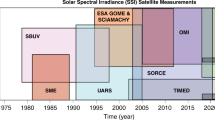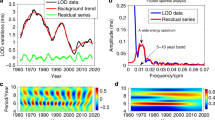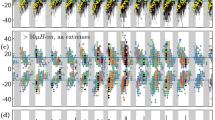Abstract
The origin of the 11- and 22-year solar cycles remains one of the more mysterious aspects of the Sun. These cycles are probably driven by convection in the solar interior, but the convection zone is difficult to probe. Small departures from sphericity in the effective surface temperature of the Sun can in principle be used in this regard. Such variations, which are observed as changes in the surface brightness with solar latitude, may be caused by differences between the vertical and horizontal turbulent convective flows1 inside the Sun. Moreover, variations in the Sun's luminosity may be related to changes in conditions near the base of the convection zone2 that result from the magnetic (sunspot) cycle3. Here we present satellite data that show that the Sun's shape and temperature vary with latitude in an unexpectedly complex way. Although the solar oblateness shows no evidence of varying with the solar cycle, we find a significant hexadecapole shape term which may vary. We also see a variation of about 1.5 K in the surface temperature with latitude. Based on these results, we suggest that sensitive observations of brightness variations be used as a record of the surface ‘shadow’ of cyclical changes in the solar interior.
This is a preview of subscription content, access via your institution
Access options
Subscribe to this journal
Receive 51 print issues and online access
$199.00 per year
only $3.90 per issue
Buy this article
- Purchase on Springer Link
- Instant access to full article PDF
Prices may be subject to local taxes which are calculated during checkout



Similar content being viewed by others
References
Durney, B. R. & Roxburgh, I. Homogeneous convection and the equatorial acceleration. Sol. Phys. 16, 2–20 (1971).
Kuhn, J. R. The Structure of the Sun: VI. Winter School at IAC (eds Roca Cortes, T. & Sanchez, F.) (Cambridge Univ. Press, (1996)).
Kuhn, J. R., Libbrecht, K. G. & Dicke, R. H. The surface temperature of the Sun and changes in the solar constant. Science 242, 908–911 (1988).
Schur, W. & Ambronn, L. Messungen des Sonnendurchmessers. Astron. Mit. Koniglichen Stern. Zu Göttingen 1–126 ((1905)).
Dicke, R. H. & Goldenberg, H. M. Solar oblateness and general relativity. Phys. Rev. Lett. 18, 313–316 (1967).
Hill, H. A. & Stebbins, R. T. The intrinsic visual oblateness of the Sun. Astrophys. J. 200, 471–483 (1987).
Dicke, R. H., Kuhn, J. R. & Libbrecht, K. G. Is the solar oblateness variable? Astrophys. J. 318, 471–483 (1975).
Beardsley, B. The Visual Shape and Multipole Moments of the Sun.Thesis, Univ. Arizona((1987)).
Rösch, J., Rozelot, J. P., Deslandes, H. & Desnoux, V. Anew estimate of the quadrupole moment of the Sun. Solar Phys. 165, 1–11 (1996).
Lydon, T. J. & Sofia, S. Ameasurement of the shape of the solar disk. Phys. Rev. Lett. 76, 177–179 (1996).
Rozelot, J. P. & Rösch, J. An upper bound to the solar oblateness. Solar Phys. 172, 11–18 (1997).
Scherrer, P. H. et al. The Solar Oscillations Investigation—Michelson Doppler Imager: The SOHO Mission (eds Fleck, B., Domingo, V. & Polland, A.) (Kluwer, Holland, (1995)).
Kuhn, J. R. et al. Sounding Solar and Stellar Interiors (ed. Berthomieu, G.) (Kluwer, Holland, (1997)).
Lites, B. The extreme limb of the Sun. Sol. Phys. 85, 193–210 (1983).
Kuhn, J. R., Lin, H. & Loranz, D. Gain calibrating nonuniform image-array data using only the image data. Publ. Astron. Soc. Pacif. 103, 1097–1108 (1991).
Acknowledgements
We thank J. Saba, C. DeForest and J. Covington for their assistance in operating the MDI instrument; L. Allen, H. Schweitzer, J.-P. Olive and K. Miller for the planning and execution of SOHO roll manoeuvrers; and the SOHO flight operations team, including H. Benefield, N. Piston and B.Sapper, for making these activities run flawlessly. This work was supported by NASA. We dedicate this work to the memory of Robert H. Dicke, who inspired a generation of astrophysicists to consider the measurement and interpretation of the shape of the Sun.
Author information
Authors and Affiliations
Corresponding author
Rights and permissions
About this article
Cite this article
Kuhn, J., Bush, R., Scheick, X. et al. The Sun's shape and brightness. Nature 392, 155–157 (1998). https://doi.org/10.1038/32361
Received:
Accepted:
Issue Date:
DOI: https://doi.org/10.1038/32361
This article is cited by
-
Surface and interior meridional circulation in the Sun
Living Reviews in Solar Physics (2022)
-
Toward Spectroscopically Detecting the Global Latitudinal Temperature Variation on the Solar Surface
Solar Physics (2017)
-
Global seismology of the Sun
Living Reviews in Solar Physics (2016)
-
On the Determination and Constancy of the Solar Oblateness
Solar Physics (2015)
-
Revisiting the Solar Oblateness: Is Relevant Astrophysics Possible?
Solar Physics (2013)
Comments
By submitting a comment you agree to abide by our Terms and Community Guidelines. If you find something abusive or that does not comply with our terms or guidelines please flag it as inappropriate.



